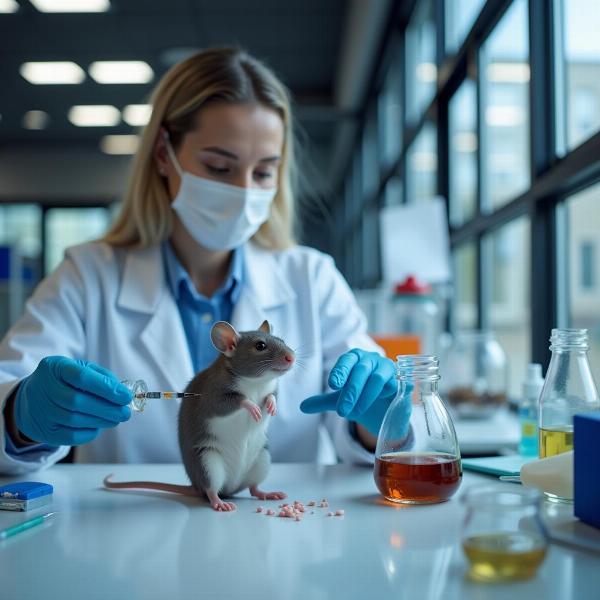In vivo meaning in Hindi centers around the phrase “जीवित प्राणी में” (jeevit prani mein), which translates to “within a living organism.” Understanding the concept of in vivo is crucial in various fields, from medical research to drug development and even agriculture. This article will delve deep into the meaning, applications, and significance of “in vivo” in Hindi, providing a clear and comprehensive understanding of this important term.
Understanding “In Vivo”
The term “in vivo” originates from Latin, literally meaning “within the living.” It refers to experimentation or observations done on a whole, living organism, as opposed to a partial or dead organism, or in an artificial environment outside the organism. This contrasts with “in vitro” (within the glass), which refers to studies performed outside of a living organism, often in a controlled environment like a test tube or petri dish. The distinction between in vivo and in vitro is fundamental in scientific research, influencing how experiments are designed, interpreted, and applied.
 In Vivo Experiment
In Vivo Experiment
In Vivo Applications in Various Fields
“In vivo” studies are essential across numerous disciplines. In medical research, in vivo trials are crucial for testing drug efficacy and safety. They help understand how drugs interact with the body’s complex systems, including their absorption, distribution, metabolism, and excretion. In agriculture, in vivo studies are used to assess the effects of pesticides, herbicides, and fertilizers on crops and livestock. Even in environmental science, in vivo research helps determine the impact of pollutants on living organisms within their natural ecosystems.
In Vivo in Medical Research
In medical research, in vivo studies are used in various stages of drug development, from preclinical testing to clinical trials. Animal models are frequently used in preclinical studies to assess drug safety and efficacy before human trials begin. Clinical trials, conducted on human volunteers, represent the final stage of in vivo testing before a drug can be approved for market. These trials are categorized into different phases, each designed to assess specific aspects of the drug, including its safety, dosage, and effectiveness.
Importance of In Vivo Studies
In vivo research offers unique insights that cannot be obtained through in vitro methods. It allows scientists to study complex interactions within a living organism, considering factors like the immune system, hormonal responses, and organ function. While in vitro studies provide valuable preliminary data, in vivo studies are necessary to confirm these findings and translate them to real-world applications. For instance, a drug may show promising results in vitro, but its efficacy and safety can only be definitively established through in vivo trials.
In Vivo vs. In Vitro: Key Differences
Understanding the difference between in vivo and in vitro is paramount. In vivo studies offer a more realistic representation of biological processes, while in vitro studies provide a simplified and controlled environment for examining specific mechanisms. Choosing the appropriate method depends on the research question and the stage of investigation. Often, a combination of both approaches is employed to gain a comprehensive understanding of a biological phenomenon.
Conclusion
“In vivo” in Hindi translates to “जीवित प्राणी में” (jeevit prani mein), meaning within a living organism. In vivo studies are indispensable across diverse fields, offering unique insights into complex biological processes. Understanding the concept and applications of in vivo is crucial for interpreting scientific research and appreciating its impact on our lives, from medicine and agriculture to environmental science. The term in vivo emphasizes the importance of studying life in its natural context.
FAQ
- What is the exact meaning of “in vivo” in Hindi? The most accurate translation is “जीवित प्राणी में” (jeevit prani mein), meaning “within a living organism.”
- Why are in vivo studies important? They allow for a realistic assessment of biological processes within a living organism, considering factors that cannot be replicated in vitro.
- What are some examples of in vivo studies? Clinical trials for new drugs, animal studies to assess drug safety, and field trials in agriculture.
- What is the difference between in vivo and in vitro? In vivo refers to studies within a living organism, while in vitro refers to studies performed outside a living organism, typically in a controlled environment.
- When should in vivo studies be used? When it is necessary to study the complex interactions within a living organism and when the research question requires a realistic biological context.
- Are in vivo studies always ethical? Ethical considerations are crucial, especially when using animal models. Strict guidelines and regulations are in place to ensure the ethical treatment of animals in research.
- Can in vivo studies be used in environmental research? Yes, they are used to assess the impact of pollution on living organisms within their natural ecosystems.
Meaning-Hindi.in is your trusted partner for accurate and culturally sensitive Hindi translations. We offer a comprehensive range of translation services, from business and legal documents to technical manuals and website localization. Our team of expert linguists ensures high-quality translations that meet your specific needs. Contact us today at [email protected] or +91 11-4502-7584. Meaning-Hindi.in provides expert translation services for business, legal, technical, and academic documents.